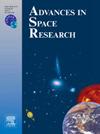利用深度强化学习进行风场中的平流层飞艇轨迹规划
IF 2.8
3区 地球科学
Q2 ASTRONOMY & ASTROPHYSICS
引用次数: 0
摘要
平流层飞艇续航时间长、飞行高度高、有效载荷容量大,在地球观测和移动互联网应用中大有可为。然而,在动态风场中规划飞行轨迹时,由于其飞行速度低、机动性有限以及能量限制,会面临一些挑战。本文提出了一种基于深度强化学习的平流层飞艇轨迹规划方法。该模型考虑了平流层飞艇的运动特性以及风场和太阳辐射等环境因素。利用软演员批评(SAC)算法评估了该方法在各种情况下的有效性。对时间优化轨迹和能量优化轨迹进行比较后发现,时间优化轨迹更平滑,速度更快,而能量优化轨迹通过利用风场和太阳能吸收可节省多达10%的能量。总之,深度强化学习方法在平流层飞艇在确定性和动态风场中的轨迹规划中证明是有效的,为飞行设计和优化提供了有价值的见解。本文章由计算机程序翻译,如有差异,请以英文原文为准。
Stratospheric airship trajectory planning in wind field using deep reinforcement learning
Stratospheric airships, with their long endurance, high flight altitude, and large payload capacity, show promise in earth observation and mobile internet applications. However, challenges arise due to their low flight speed, limited maneuverability and energy constraints when planning trajectories in dynamic wind fields. This paper proposes a deep reinforcement learning-based method for trajectory planning of stratospheric airships. The model considers the motion characteristics of stratospheric airships and environmental factors like wind fields and solar radiation. The soft actor-critic (SAC) algorithm is utilized to assess the effectiveness of the method in various scenarios. A comparison between time-optimized and energy-optimized trajectories reveals that time-optimized trajectories are smoother with a higher speed, while energy-optimized trajectories can save up to 10% energy by utilizing wind fields and solar energy absorption. Overall, the deep reinforcement learning approach proves effective in trajectory planning for stratospheric airships in deterministic and dynamic wind fields, offering valuable insights for flight design and optimization.
求助全文
通过发布文献求助,成功后即可免费获取论文全文。
去求助
来源期刊

Advances in Space Research
地学天文-地球科学综合
CiteScore
5.20
自引率
11.50%
发文量
800
审稿时长
5.8 months
期刊介绍:
The COSPAR publication Advances in Space Research (ASR) is an open journal covering all areas of space research including: space studies of the Earth''s surface, meteorology, climate, the Earth-Moon system, planets and small bodies of the solar system, upper atmospheres, ionospheres and magnetospheres of the Earth and planets including reference atmospheres, space plasmas in the solar system, astrophysics from space, materials sciences in space, fundamental physics in space, space debris, space weather, Earth observations of space phenomena, etc.
NB: Please note that manuscripts related to life sciences as related to space are no more accepted for submission to Advances in Space Research. Such manuscripts should now be submitted to the new COSPAR Journal Life Sciences in Space Research (LSSR).
All submissions are reviewed by two scientists in the field. COSPAR is an interdisciplinary scientific organization concerned with the progress of space research on an international scale. Operating under the rules of ICSU, COSPAR ignores political considerations and considers all questions solely from the scientific viewpoint.
 求助内容:
求助内容: 应助结果提醒方式:
应助结果提醒方式:


